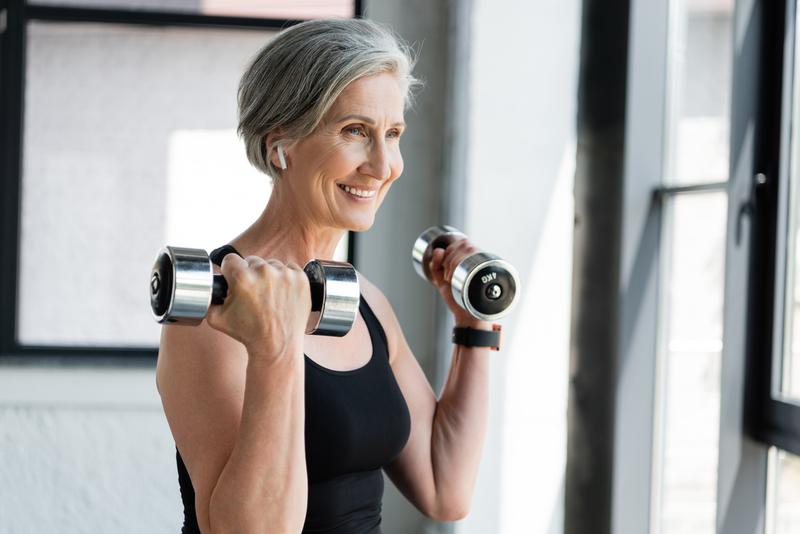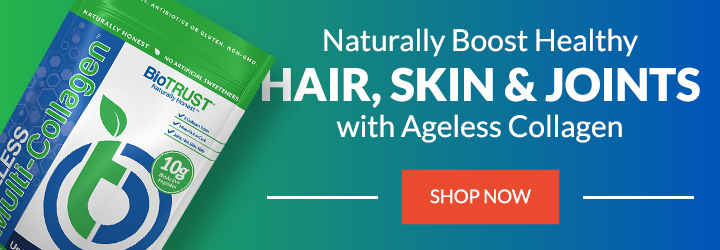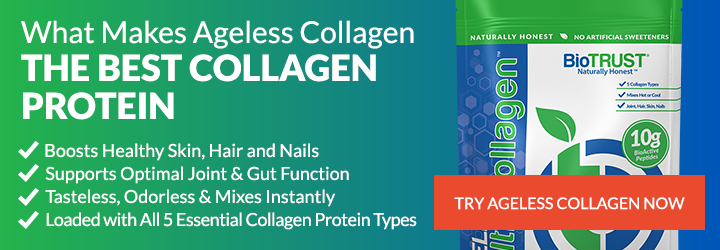How to Build Healthy Bones (5 Easy Tips)

Knowing how to build healthy bones is a lifelong endeavor as the 206 bones found throughout the body are constantly remodeling. That is, they break down and rebuild in a complex dance of nutrients, including minerals and vitamins.
Collectively, our bones support the rest of the tissues in the body and allow us to move through the world. What’s more, they protect delicate tissues, such as the brain, heart, and other organs, from injury.
As we get older, some bone loss is likely inevitable. Fortunately, there are many actions we can take to help keep our bones strong and healthy well into our senior years, especially if we start when we’re a bit younger, as by age 30, most of us have reached our peak for bone mass.
Bone Tissue Types
There are two types of bone tissue in the body. The first is called cancellous bone, trabecular bone, or spongy bone. This is the light, porous bone on the inside that looks like latticework (or a sponge) if you cut the bone crosswise. The body can use the minerals, especially calcium and phosphorous, in this part of the bone to make up for deficiencies. For example, when there are low calcium levels in the blood, the body can take that calcium from bone tissue. Starting around the age of 30, we can lose a bit more bone mass than we build, especially if we don’t take action to build healthy bones.
The other type of bone tissue is called compact or cortical bone. This dense outer shell covers each bone and makes up 80% of the human skeleton. This bone tissue holds onto nutrients more tightly, but we can lose mass starting at around age 40.
How Do You Know If You Need to Build Healthy Bones?
As long as we’re living, we need to build stronger, healthier bones—it’s an ongoing process throughout life. But this becomes even more crucial if:
- You have a family history of bone loss or hip fractures, which is more common among people of white or Asian descent
- You have been a long-time smoker
- You drink excessively
- You have been prescribed glucocorticoid drugs (used to help regulate the immune system)
- You’ve suffered a previous fracture, especially if little or no trauma was involved
- You don’t eat a well-balanced, nutrient-rich diet
- You’re sedentary
- You’re a woman (as women naturally have less bone tissue than men, especially as they age)
- You have a small body frame or are extremely thin
- You have a hormone imbalance, such as too much thyroid, decreased estrogen levels (often due to menopause), or low testosterone levels
- You’re older as bones become weaker as we age
You can have a DEXA or dual-energy X-ray absorptiometry scan (often recommended after menopause for women) to see if and how much bone you’re losing—especially if it’s leading to a disease state. This scan allows doctors to determine your bone density (i.e., how strong and dense your bones are). It can also help you understand if you’re at a higher risk of breaking a bone if you fall. Fortunately, while these scans can cost a few hundred dollars, they take little time (~15 minutes) and are painless.
How to Build Healthy Bones
Bone mass continues to ebb and flow even later in life, and many habits can help us hold onto and possibly even increase the bone tissue we have as we age. Here are the top tips to help build healthy bones:
1. Eat a Nutrient-Rich Diet
The body takes the nutrients found in food to remodel bones. Some of the most important nutrients to get from your diet to build healthy bones include:
Protein: About 50% of bone is made up of proteins, and low protein intakes can decrease calcium absorption, which can affect bone breakdown and rebuilding. Research with older women specifically has found that when they consume higher amounts of protein, they tend to have stronger bone density and a decreased risk of fractures.
Getting enough protein is especially important if you’re cutting back on calories to lose weight. Another study found that women who got sufficient levels of protein (86 grams per day) lost less bone mass on a calorie-restricted diet than those who ate only 60 grams per day.
Collagen: Collagen is the main type of protein found in bones. In fact, the amino acids it provides (glycine, proline, and lysine) are needed for the formation of bone as well as muscles and ligaments. While more studies are needed, collagen has been shown in research to help promote bone health and decrease the breakdown of collagen.
Calcium: This mineral is key to strong bones. The best sources are foods like dark leafy greens, broccoli, tofu, dairy products (yogurt, cheese, milk), beans and legumes, sardines and salmon (with edible bones), shrimp, and almonds. Some foods and drinks may also have added calcium.
Don’t just have one serving and call it good for the day. Because bones are constantly breaking down and rebuilding throughout the day, it’s important to spread calcium consumption in smaller amounts throughout the day.
While supplements are available, large dosages have been linked to an increased risk of heart disease. (In contrast, calcium consumed in foods in smaller amounts throughout the day decreased the risk of heart disease.) So, it’s better to get small amounts of calcium throughout the day from foods or low-dose supplements rather than taking a big calcium capsule once a day.
Vitamin C: This vitamin stimulates bone-forming-cell production and may even help protect bones from damage. Vitamin C is fortunately abundantly available in green and yellow vegetables like broccoli, cabbage, kale, and peppers, as well as in citrus fruits, cherries, cantaloupe, onions, and parsley. In addition, many quality supplements for skin health, immunity, and more also contain this important nutrient.
Vitamin D: One of the most important nutrients for bone health, vitamin D is needed for proper calcium absorption. We make vitamin D if we get enough sunlight exposure. Sadly, the vast majority of us don’t. Vitamin D3 is the most easily absorbed form and can be found in foods like egg yolks, saltwater fish, liver, mushrooms, and milk fortified with vitamin D.
Because it’s so difficult to get enough vitamin D, supplementation—at least 1,000 IU per day—is often recommended, especially for people as they age and those with darker skin tones.
Vitamin K: This vitamin is vital for binding minerals in bones, which helps prevent the loss of calcium. Vitamin K comes in two common forms: MK-4 and MK-7. They’re both found in small amounts in eggs, meat, and liver. MK-7 can also be found in fermented foods, including cheese, sauerkraut, and natto.
In addition to eating foods that provide this key vitamin, supplementing with vitamin K may help increase bone density in both children and post-menopausal women according to research.
Omega-3s: In addition to all of the other benefits, these essential fatty acids have been shown to help protect against bone loss, promote healthy levels of inflammation, and more. Look for omega-3 oils in fatty fish, chia seeds, flaxseeds, and walnuts. Or choose a supplement from a quality, reputable source to ensure you’re getting enough of this very important nutrient.
Magnesium: This mineral is important for converting vitamin D to its active form, so it can enhance calcium absorption. Magnesium can be found in an array of foods, including avocados, dark chocolate, nuts, legumes, and tofu. It can also be found in supplements, such as magnesium glycinate, citrate, or carbonate.
Zinc: While you need only a small amount of this mineral, zinc is another important mineral for bone health. In fact, it helps promote the formation of bone-building cells. It also helps prevent excess bone breakdown. Zinc can be found in beef, shrimp, and oysters and in spinach, flaxseeds, and pumpkin seeds, as well as in supplements.
Other nutrients important for building bone health include:
- Phosphorus, found in chicken, pork, seafood, sunflower and pumpkin seeds, nuts, and beans
- Boron, found in avocado, raisins, peaches, beans, nuts, and seeds
- Chromium, found in whole wheat, beef, green beans, and apples
- Silica, found in oats, bananas, spinach, rice, and seafood
- Manganese, found in blackberries and blueberries, black-eyed peas, black tea, brown rice, and chickpeas
- Copper, found in liver, oysters, spirulina, nuts, and seeds
- Potassium, found in avocados, sweet potatoes, spinach, watermelon, and beans
2. Add Weight-Bearing Exercises to Your Routine
As we age, many of us understand the importance of staying fit cardiovascularly. But equally important are exercises that exert force against the muscles and bones. This force stimulates the tissues to add cells. So, like muscles, bones rebuild stronger with exercise.
Ideally, combine weight-bearing exercises like walking, stair climbing, running, or something that involves jumping, such as dancing or jumping rope, with strength-building exercises, such as strength training, free weights, or bodyweight movements for at least 20 minutes twice a week. In general, it’s a good rule of thumb to move your body for at least 30 minutes every day.
If your bones have already begun to lose mass, work with your doctor and potentially physical therapist to create a program that works for your body and is safe for your current condition.
3. Manage Your Weight
It’s important to also ensure you’re eating the right calorie count for you. Eating too few can slow the metabolism, increase hunger, and lead to muscle and bone loss.
What’s more, maintaining a healthy weight helps support bone health, and being underweight increases bone loss, especially as women get older. In fact, low body weight is one of the main contributors to decreased bone density in older women.
On the other end, being obese can also lead to bone loss. And yo-yo dieting, where people repeatedly lose and regain weight, can be particularly hard on bone health.
When it comes to how to build bone health, strive to obtain and then maintain a stable, normal (or slightly higher) weight.
4. Make Healthy Lifestyle Choices
Both drinking excessively and smoking have been found to interfere with bone health. If you choose to drink, please do so in moderation; that is, one drink per day for women and two for men.
It also is a good idea to limit tripping hazards. For example, make sure throw rugs don’t bunch up, use non-slip mats on floors and showers to prevent bathroom falls, and remove clutter, especially from walkways. Plus, ensure your walkways are well-lit.
Most falls can be prevented just by knowing your surroundings and being able to see what’s around you, so make sure your vision is checked regularly, and replace lightbulbs when they’re out. You can also help prevent falls by working on your balance, practicing yoga, or taking Tai Chi classes.
5. Manage Health Conditions
Having another health problem can increase the risk of bone loss. For instance, asthma, allergies, cancer, Cushing disease, diabetes, hyperthyroidism, inflammatory bowel disease, lactose intolerance, lupus, liver or kidney disease, lung disease, multiple sclerosis, and rheumatoid arthritis have all been associated with greater bone loss. If you have a health issue, work with your medical team to help protect your bones.
Keeping our bones healthy and strong is important throughout life, especially as we age. Broken bones (i.e., fractures) can be painful and may need extensive physical therapy or even surgery to heal correctly. If they don’t heal, it can lead to long-lasting issues.
Fortunately, there are steps we can easily take to build healthy bones and help keep them strong for years and years and years to come.









